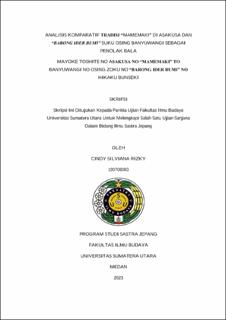| dc.description.abstract | This research discusses the comparative analysis of the Mamemaki tradition in the
city of Asakusa and the Barong Ider Bumi tradition of the Osing tribe of
Banyuwangi. The aim of this research is to look for similarities and differences
between the two traditions, especially in their performance. This research describes
the meaning of tradition, history, as well as procedures for implementation and
performance in these two traditions. This research used qualitative descriptive
methods and library methods. The data collected comes from literature studies in
the form of books, journals, websites, articles, videos and images as support. The
results of this research show that Mameki and Barong Ider Bumi have something
in common, namely as a tradition to ward off all evil or a tradition to repel evil. The
tradition of repelling evil is a tradition of banishing bad luck and aims to bring good
luck to the people who practice it. The differences between these two traditions can
be seen in terms of time, place and media used. What these two traditions have in
common is that they use agricultural grains, namely beans and rice. Meanwhile, the
differences can be seen in terms of time, place and audience. Mamemaki is carried
out to welcome the new season, namely spring, every year on February 3 according
to the solar calendar. Mamemaki is done at temples because it is based on Shinto
religious beliefs. Mamemaki is attended by local Japanese and foreign people to
worship and travel. Meanwhile, Barong Ider Bumi is performed according to
Islamic religious beliefs, namely during the celebration of Eid al-Fitr, namely the
2nd of Shawwal according to the Hijri calendar. This tradition is carried out by
holding a procession along the streets of Kemiren Village with the aim of driving
away the reinforcements around Kemiren Village. | en_US |



